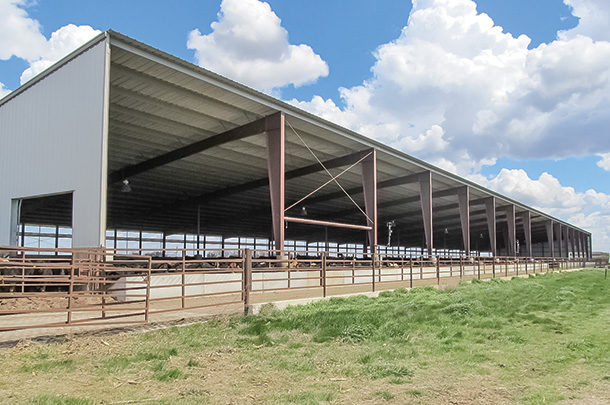Areas of the U.S. have witnessed the growing use of monoslope buildings for beef operations as feedyards expand and adapt, but this trend hasn’t established itself in all cattle-raising regions. A large factor limiting this expansion is state-specific weather conditions, says Beth Doran, extension and outreach beef specialist at Iowa State University.
She explains states in the upper Midwest experience more rainfall and colder climates than those in other parts of the country. Iowa from 2017 to 2020 received between 29 to 45 inches of rain, 19 to 48 inches of snow and temperatures within the 45- to 50-degree average.
“Weather is a reason why we’re seeing more barns and monoslopes in those regions. Producers with this much precipitation must be careful about runoff, and containing manure within the structure of a building is a way to do that,” she said.
Monoslope weather and manure advantages
Doran says other basic advantages monoslope barns deliver include animal comfort in both winter and summer temperatures, the potential for improved performance during inclement weather, reduced sickness and valuable manure for cropland fertilizer.
“A large factor is we can increase, or at least retain, more nitrogen as it’s not part of the runoff,” she said. “In an open feedlot, studies show approximately 11 pounds of total nitrogen per ton of manure and in deep-bedded monoslopes, we see about 21.7 pounds. That 10 pounds of extra nitrogen, coupled with the increased volume of material, makes a difference in the value of the manure.”

A feed alley along the north wall of a monoslope, deep-pit beef barn. Photo provided by Erin Cortus.
Erin Cortus, associate professor and extension engineer at the University of Minnesota, agrees and adds that since manure is contained under a roofed building, runoff is essentially eliminated and the environmental risk is substantially less in comparison to open feedlots.
She notes that around 2010, most monoslope and gable barns were managed with bedded pack, but over the past five years, many have moved to a deep-pit management system. These distinct approaches produce radically different qualities and types of waste with bedding packs being mostly solid and deep pits holding a liquid or slurry.
“Manure value is based on the amount of nitrogen, phosphorous and potassium. Because of its retention, we’re getting more concentration and nutrient content with both the packs and deep pits.”
Additional monoslope benefits
Cortus says financial assistance is available whenever runoff control is evaluated.
“Opportunity for cost share exists through the USDA and NRCS because using a roof and pit system reduces runoff risk. There’s an economic incentive tied to the environmental risk reduction.”
While operating in a monoslope doesn’t necessarily reduce labor demands, it makes tasks and management more routine for workers who aren’t being subjected to the weather of an open lot, particularly in extreme cold and hot weather.

Cattle stand in front and on top of a bed pack. Photo provided by Erin Cortus.
Cattle density is another advantage as the overall footprint is reduced. Square footage is decreased, allowing the placement of more animals in a land base.
“Land is expensive as it is,” she said. “And many farmers want to bring family members back into an operation. Barns enable growth in increasing numbers in a smaller area.”
More deep-pit designs are being built, but most producers Cortus speaks with speculate that the pits work well in finishing facilities, but bedded packs won’t completely disappear as they are more suitable for youngstock.
“Because of storage, deep pit has an even smaller square-foot-per-head requirement. This factors into design choice, but bedded pack with the softer footing makes for a healthier environment for younger livestock.”
Performance, management and cost
Potentially, the largest benefit of covered buildings is an increase in production efficiency due to level of comfort. Weather effects such as temperature, wind, precipitation, humidity, mud buildup and solar radiation, are diminished.
In 2006, the South Dakota State University Cooperative Extension Service completed a trial at their Opportunities Farm evaluating average daily gain (ADG) and feed efficiency of cattle fed in an open feedlot, a partially covered lot and a confined monoslope barn. They found both were higher and improved in the confined and sheltered groups in comparison to the open lot. Additionally, pull rates for sickness, lameness and mortality were noticeably higher in the open lot versus the partially covered and confined systems. Although results favored a covered approach, data and numbers were limited and yearly quarter information was variable.
Doran explains while cattle in a monoslope building have the potential for higher performance rates, confined facilities must be managed differently than open lots. More bedding and cleaning are required due to the containment aspect, with local producers generally cleaning at least twice a week around pack edges. Deep-pit structures also need manure handled. Water to suspend the solids is usually added with pumping out occurring twice a year.
Building cost is also a large factor to consider in comparison to creating an open lot. Traditional outdoor feedlots also need a handling method, most using either a concrete or an earthen basin storage with settling solids, but this cost is much less than pouring a concrete floor and building a roof along with the infrastructure of a barn. A slatted-floor facility will have the same costs as the deep-bedded option, plus extra concrete expense due to the pit and mats covering the slats.
Doran recommends that those choosing a monoslope option orient the building from east to west, helping ensure air moves through in both summer and winter. This positioning takes advantage of the higher summer sun while offering more shade in the rear. During winter, rear curtains can be partially closed while still allowing sufficient air flow and ventilation.
She admits, while weather conditions remain a large factor, management plays a key role.
“I think we can make any facility work, even in our climate. But we need to manage them differently in terms of bedding amounts, how we deliver feed and how often we clean and bed. Barns can provide excellent animal comfort, and potential performance increases depending on the season, plus an improved quality of manure, but much of it comes back to management practices.”












